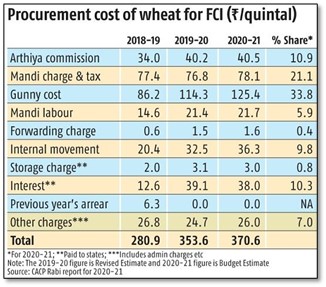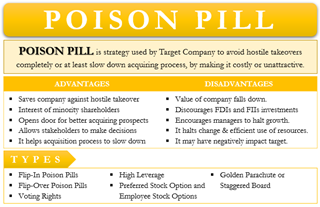Monday, 25th April 2022
Demolition drive
In News
The North Delhi Municipal Corporation’s (NDMC) demolition drive in Jahangirpuri may get stalled in light of a 1985 Supreme Court order on pavement dwellers.
About the News
- Following a spate of communal violence in North Delhi’s Jahangirpuri, NDMC began a demolition drive to remove encroachment, demolishing roadside stalls, push carts and businesses.
- Soon after the demolitions started, the Supreme Court ordered in an urgent hearing that the demolitions be halted and status quo maintained.
- Human right activists and jurists have voiced concerns that the demolition drives are in contravention to certain laws and are targeting a particular community and are a form of ‘collective punishment’.
What is Land encroachment?
- Land encroachment is an illegal movement of a person on someone else's property including public property with the aim of possession of a property.
- Land encroachment is a punishable offence under section 441 of the Indian Penal Code.
- The right to reside and settle in any part of India under Article 19 (1) (e) cannot be read to confer the licence to encroach and trespass upon public property.
- A Special task Force under Ministry of Housing and Urban Affairs (MoHUA) meets every fortnight to review complaints and action taken by all the civic bodies of India which includes land encroachment.
The laws being contravened in following Ways
In case of permanent structures:
- None of the applicable state laws: The Delhi Municipal Corporation Act, 1957 or Delhi Development Act, 1957 – allow the government agency to demolish buildings and structures without giving an advance notice to the affected parties.
- Since houses and other permanent structures were included in the demolition drive, serving an advance notice under the Section 343 of the Delhi Municipal Corporation Act, 1957 was imperative.
- Without a reasonable opportunity to be heard, the rights of the affected people under Article 14 of the Constitution, which ensures equality before the law, are violated.
In case of temporary structures:
- In the 1985 Olga Tellis case Supreme Court verdict of a five-judge Bench led by then Chief Justice of India Y.V. Chandrachud had held that the pavement dwellers cannot be treated as trespassers and their eviction should not lead to deprivation of their livelihoods.
- The court had said that they should not be subject to harassment adding that their right to livelihood was an integral part of the right to life under Article 21 of the Constitution.
- The eviction of pavement dwellers and traders should be in accordance with the procedure established by law, the 1985 Constitution Bench had held.
- Any action taken by a public authority which is invested with statutory powers has to be tested by the application of two standards –
- The action must be within the scope of the authority conferred by law and
- it must be reasonable.
- In 2017 SC had observed that authorities cannot say these people were not entitled to relocation because they had been obstructing the “right of way” of the public.
- Right to shelter was a fundamental right under Article 21.
- It was a right recognised by international conventions and an integral part of the principles of natural justice.
- The authorities should ensure that people displaced were provided basic civic amenities at the site of relocation.
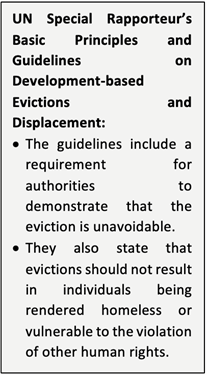
Sources:
- Jahangirpuri | 1985 Supreme Court order on pavement dwellers could stall NDMC demolition drive
- As bulldozer threats rise, what the Rule of Law says on demolitions
- Despite BJP's Claims, Jahangirpuri Demolitions Were Far From a Legitimate Anti-Encroachment Drive
- Encroachment of public land or right to live?
Phone tapping in India
In News
An IPS officer is under the scanner for Phone tapping of political leaders in Maharashtra.
About the News
- Phone tapping orders are by an order made by the Secretary to the Government of India in the Ministry of Home Affairs in the case of Government of India.
- For states, the same is issued by the Secretary to the State Government in-charge of the Home Department in the case of a State Government.
- The order has to conveyed to the service provider in writing; only then can the tapping begin.
What are the laws govern tapping a phone in India?
- Authority to tap phone:
- States: In the states, police have the powers to tap
- Centre: At the Centre, 10 agencies are authorised to do so including Intelligence Bureau, CBI, Enforcement Directorate, Narcotics Control Bureau, Central Board of Direct Taxes, Directorate of Revenue Intelligence, National Investigation Agency, R&AW, Directorate of Signal Intelligence, and the Delhi Police Commissioner.
- Illegal: Tapping by any other agency would be considered illegal.
- Governing laws:
- Telegraph act 1885: It governs the Phone tapping in India according to which “on the occurrence of any public emergency, or in the interest of the public safety”, phone tapping can be done by the Centre or states.
- Condition: If the centre or state are satisfied that tapping is necessary in the interest of “public safety”, “sovereignty and integrity of India, the security of the State, friendly relations with foreign States or public order or for preventing incitement to the commission of an offence”.
- Exceptions: There is an exception for the press: “press messages intended to be published in India of correspondents accredited to the Central Government or a State Government shall not be intercepted or detained, unless their transmission has been prohibited under this sub-section”.
- Records: The competent authority must record reasons for tapping in writing.
- Emergency provision:
- Unavoidable circumstances: Order may be issued by an officer, not below the rank of a Joint Secretary to the Government of India, who has been authorised by the Union Home Secretary, or the State Home Secretary.
- Remote areas: In remote areas or for operational reasons, if it is not feasible to get prior directions, a call can be intercepted with the prior approval of the head or the second senior-most officer of the authorised law enforcement agency at the central level, and by authorised officers, not below the rank of Inspector General of Police, at the state level.
- Time limit: The order has to be communicated within three days to the competent authority, who has to approve or disapprove it within seven working days. If the confirmation is not received within the stipulated seven days, such interception shall cease.
What are the Checks against misuse of Phone tapping?
- Last resort: The law is clear that interception must be ordered only if there is no other way of getting the information.
- Fixed duration: The directions for interception remain in force, unless revoked earlier, for a period not exceeding 60 days. They may be renewed, but not beyond a total of 180 days.
- Reasonable grounds: Any order issued by the competent authority has to contain reasons, and a copy is to be forwarded to a review committee within seven working days. At the Centre, the committee is headed by the Cabinet Secretary with the Law and Telecom Secretaries as members. In states, it is headed by the Chief Secretary with the Law and Home Secretaries as members.
- Review of requests: The committee is expected to meet at least once in two months to review all interception requests.
- Destruction of records: Records pertaining to such directions must be destroyed every six months unless these are, or are likely to be, required for functional requirements. Service providers too are required to destroy records pertaining to directions for interception within two months of discontinuance of the interception.
- Ensuring privacy: The service providers are required to put in place adequate and effective internal checks to ensure that unauthorised interception of messages does not take place and extreme secrecy is maintained.
Sources:
European Union ground rules for Web
In News
The European Parliament and European Union (EU) Member States have recently announced that they had reached a political agreement on the Digital Services Act (DSA).
About the News
- Digital Services Act (DSA) is a landmark legislation that intends to force big Internet companies to act against disinformation and illegal and harmful content, and to provide better protection for Internet users and their fundamental rights.
- It is yet to become law and has been proposed by the EU Commission in The proposed Act will work in conjunction with the EU’s Digital Markets Act (DMA), which was approved last month.
Understanding the Digital Services Act (DSA)
- What is it? The DSA is a set of legislation that will tightly regulate the way intermediaries, especially large platforms such as Google, Facebook and YouTube, function when it comes to moderating user content.
- Instead of letting platforms decide how to deal with abusive or illegal content, the DSA will lay down specific rules and obligations for these companies to follow.
- To whom will it apply?
- DSA will apply to a large category of online services, from simple websites to Internet infrastructure services and online platforms. The obligations for each of these will differ according to their size and role.
- The legislation brings in its ambit platforms that provide Internet access, domain name registrars, hosting services such as cloud computing and web-hosting services.
- More importantly, very large online platforms (VLOPs) and very large online search engines (VLOSEs) will face “more stringent requirements.”
- Any service with more than 45 million monthly active users in the EU will fall into this category.
- Those with under 45 million monthly active users in the EU will be exempt from certain new obligations.
- Enforcement: Once the DSA becomes law, each EU Member State will have the primary role in enforcing these, along with a new “European Board for Digital Services.”
- The EU Commission will carry out “enhanced supervision and enforcement” for the VLOPs and VLOSEs.
- Breach of Rules: Penalties for breaching these rules could be as high as 6% of the company’s global annual turnover.
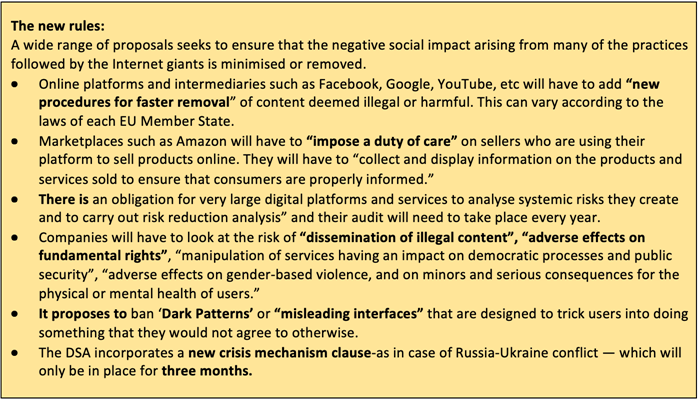
Does this mean that social media platforms will now be liable for any unlawful content?
- The platforms and other intermediaries will not be liable for the unlawful behaviour of users. So, they still have ‘safe harbour’ in some sense.
- However, if the platforms are “aware of illegal acts and fail to remove them,” they will be liable for this user behaviour.
- India’s IT Rules announced last year make the social media intermediary and its executives liable if the company fails to carry out due diligence.
- Rule 4 (a) states that significant social media intermediaries such as Facebook or Google must appoint a chief compliance officer (CCO), who could be booked if a tweet or post that violates local laws is not removed within the stipulated period.
Source:
World Malaria Day 2022
On April 25, 2008, 'World Malaria Day' was observed for the first time. Every year, World Malaria Day is observed on April 25 to create a global awareness of the disease named malaria. The theme for this year's malaria day is ‘Harness innovation to reduce the malaria disease burden and save lives. World malaria day first began as Africa Malaria Day. This day has been observed by the African government since 2001 but was first marked in 2008. The day holds its significance, as despite being a treatable disease, Malaria continues to have a devastating impact on the livelihood of people across the planet. As per WHO, the year 2020 witnessed around 241 million new cases of malaria and 627,000 malaria-related fatalities in 85 nations. Malaria is transmitted via the bite of female Anopheles mosquitoes that are infected by the plasmodium parasite. And when a mosquito bites a human, a parasite is released into the bloodstream, resulting in malaria.
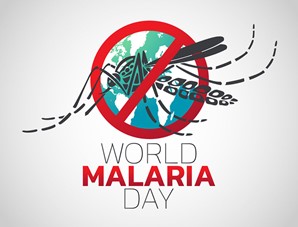
Sources:
Battery Swapping Policy
In News
Niti Aayog has released a draft battery swapping policy to catalyze the large-scale adoption of Electric Vehicles (EVs).
About the News
- The NITI Aayog will ensure large scale adoption by improving efficient and effective use of scarce resources (viz. public funds, land, and raw materials for advanced cell batteries) for the delivery of customer centric services.
- The Aayog has proposed that all metropolitan cities with a population of more than 40 lakh will be prioritised for the development of battery swapping networks under the first phase, which is within 1-2 years of the draft policy getting finalised.
- Other major cities such as state capitals with a population greater than 5 lakh will be covered under the second phase.
- Bureau of Energy Efficiency will be the nodal agency responsible for rollout of EV public charging infrastructure.
What is battery swapping?
- Battery swapping is a mechanism that involves exchanging discharged or partially charged batteries of EVs batteries for charged ones manually or with mechanical intervention.
- With such a policy, customers in India can buy a vehicle without a battery and take it on lease from an energy operator.
- The EO purchases and owns the batteries and sets up bulk charging stations to charge multiple discharged batteries. EO also sets up a network of city-wide swapping stations and charges users on a per swap basis.
- Battery swapping is generally used for smaller vehicles such as two-wheelers and three-wheelers with smaller batteries that are easier to swap, compared to four-wheelers and e-buses, although solutions are emerging for these larger segments as well.
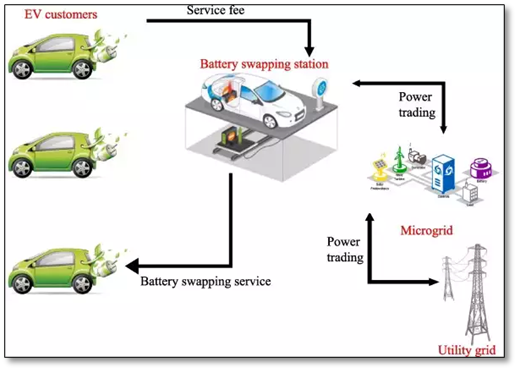
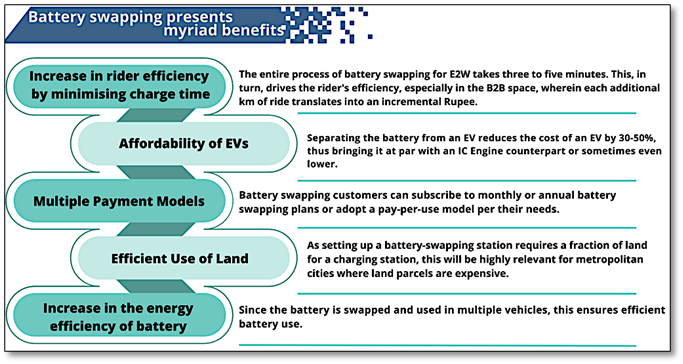
Need for such a policy
- Carbon Commitments: India has committed to achieving net-zero emissions by 2070 COP26, which will require clear pathways to decarbonize high greenhouse gas (GHG) intensive sectors such as transport and energy.
- Decarbonizing of transport sector will be spearheaded by the transition to clean mobility, led by electric vehicles (EVs).
- E-Mobility: India is on the cusp of an e-mobility revolution led by the two-wheeler (2W) and three-wheeler (3W) vehicle segments. 2Ws account for 70-80% of all private vehicles, and 3Ws play a critical role for public transit, freight transport and last mile connectivity in cities.
- Battery swapping offers three key advantages relative to charging: it is time, space, and cost efficient, provided each swappable battery is actively used.
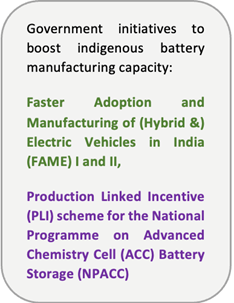
Key proposals in the draft policy
- The GST Council will consider reducing the differential across the tax rates on Lithium-ion batteries and electric vehicle supply equipment. Currently, the tax rate on the former is 18 per cent, and 5 per cent on the latter.
- Contractual relationship: The policy aims to specify a minimum contract duration for a contract to be signed between EV users and battery providers to ensure they continue to provide battery swapping services after receiving the subsidy.
- Standardization: Manufacturers will have to ensure that several features come as standard, to be able to operate freely and avail subsidies. All batteries must use “Advanced Chemistry Cells” and must be Battery Management System (BMS)-enabled.
- Identification and Traceability: To implement unique traceability across the battery lifecycle, a Unique Identification Number (UIN) shall be assigned at the manufacturing stage for tracking and monitoring EV batteries. Similarly, a UIN number will be assigned to each Battery Swapping Station.
- Easy Registration Process: Transport departments are expected to ease registration process of EVs sold without batteries or vehicles with battery swapping facility.
Proposals for battery safety
- Standards approved or defined by BIS shall be implemented for the electric vehicle, battery safety requirements (tested as per AIS 156 (2020) and AIS 038 Rev 2 (2020) standards) etc. The policy will only support batteries using Advanced Chemistry Cells (ACC), with performance that is equivalent or superior to EV batteries supported under the government’s FAME-II scheme.
- ACCs are the new generation of advanced storage technologies that can store electric energy either as electrochemical or as chemical energy and convert it back to electric energy as and when required.
- To ensure a high level of protection at the electrical interface, a robust/rigorous testing protocol shall be adopted with advanced features like IoT-based battery monitoring systems, remote monitoring, and immobilisation capabilities.
- For EVs with swappable battery functionality, vehicle Original Equipment Manufacturers (OEMs) shall be required to get ARAI approval for their vehicles to accept interoperable swappable batteries.
- ARAI is authorized agency for testing and certifying vehicles and engines used for both automotive and non-automotive applications.
- To ensure safe and cost-effective infrastructure for charging and swapping of EV batteries, standards for Battery Charging Station and Battery swapping station will be developed or approved by BIS/ Ministry of Power (MoP) or other competent authorities.
Business-as-a-Service (BaaS) model
- As per Niti Aayog, battery swapping will fall under the battery-as-a-service (BaaS) business model. Battery or Energy as a Service (BaaS) allows EV owners to replace the discharged batteries with charged ones at the swap stations. When the battery is discharged, the owner can change it with a fully charged.
- The BaaS model shifts the customer - supplier relationship from the traditional model of ownership to a model that evolves around providing a service on a non-ownership basis.
To ensure that BaaS models lead to large scale adoption among EV users, following has been suggested:

Conclusion: The draft policy, which comes amid rising concerns over safety of electric vehicles following a spate of incidents of electric two-wheelers catching fire, would be a good step for the government to ensure safety facilities be inbuilt in the EV batteries. Transition to EV has become imperative for the future, and it needs to be safe and attractive for the user to make the switch.

For article related to the topic, refer:
- https://edukemy.com/current-affairs/gazette/2022-02-18/battery-as-a-service-baas
- https://edukemy.com/current-affairs/gazette/2021-12-01/fame-ii-scheme
- https://edukemy.com/current-affairs/gazette/2022-01-25/the-delhi-ev-policy
- https://edukemy.com/current-affairs/gazette/2022-03-31/evs-catching-fire
- https://edukemy.com/current-affairs/gazette/2021-11-17/e-amrit-portal
Sources:
- Explained: What are the key proposals in Niti Aayog’s draft battery swapping policy?
- BATTERY SWAPPING POLICY
- NITI Aayog’s draft policy on battery swapping explained
- NITI Aayog releases draft battery-swapping policy
- Battery swapping policy to level the playing field for operators
- ‘As a service’ business models: What it is and its benefits
- Battery Swapping – the nitty-gritty you need to know:
Phanigiri: An Ancient Buddhist Site in Telangana
This is image of a panel found at Phanigiri, Talangana. The ancient monastery of Phanigiri referred to as kari mahavihara, functioned between the 1st and 4th centuries CE. Discovered in Suryapet district in 1942, it lies embedded like a gem in the granite hills of Telangana. The monastery’s unusual name was probably drawn from its location on a hill (giri) shaped like a snake’s hood (phan). The Deccan-Gandharan connection in art and architecture visible in the high relief and three-dimensional sculptures found at Phanigiri, in the choice of motifs on decorative borders, in the portrayal of semi-divine figures like ganas, yakshas, mithunas and nagas and in the depiction of biographical details from the Buddha’s life. The octagonal pillar inscription recalls the donation of a Dhammachakra by the royal physician Nandinnaka at the time of king Rudrapurushadatta of the Ikshvaku dynasty.
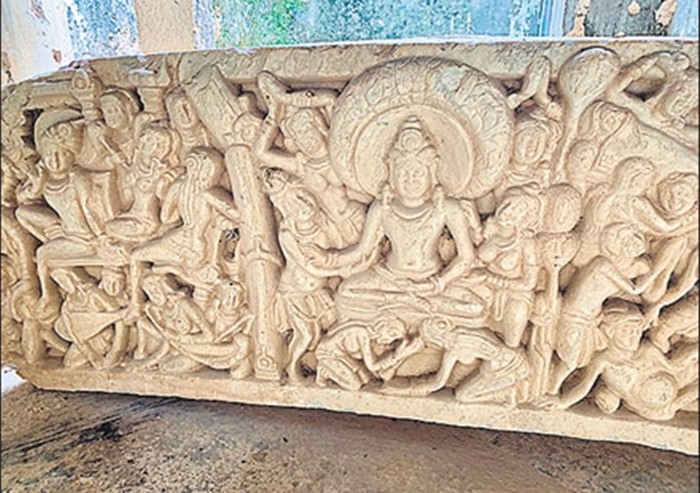
Source:
SPACs
- Context: The government has been reportedly considering a regulatory framework for special purpose acquisition companies (SPACs) to lay the ground for the possible listing of Indian companies through this route in the future.
- An SPAC, or a blank-cheque company, is an entity specifically set up with the objective of acquiring a firm in a particular sector.
- It aims to raise money in an initial public offering (IPO) without any operations or revenues.
- The money that is raised from the public is kept in an escrow account, which can be accessed while making the acquisition.
- A minimum of 85% of the SPAC IPO proceeds must be held in the escrow account (typically, more than that percentage is held in escrow) for potential acquisitions.
- These funds are usually invested in government bonds while the SPAC sponsor seeks acquisition targets.
- If the acquisition is not made within two years of the IPO, the SPAC is delisted and the money is returned to the investors.
- Investors in SPACs can range from well-known private equity funds and celebrities to the general public.
- The management team of a SPAC (which includes sponsors, directors, officers, and affiliates) decides which companies to potentially acquire.

Source:
- Explained: What are SPACs for which a regulatory framework may be in the works?
- Govt eyes SPAC framework to enable new listing group
Image source:
Cosmos Malabaricus project
- Context: Kerala and the Netherlands have recently signed a (MoU) for project ‘Cosmos Malabaricus’.
- The project aims to illustrate the history (political, social, economic, and cultural) of Kerala in the 18th century.
- It deals with the 18th century Dutch documents on Malabar which are considered the most extensive source of information about the period in Kerala between 1643 and 1852.
- The documents have remained underutilized by historians and researchers since it is written in the Dutch script prevalent in the 17th and 18th centuries and therefore, the signatories have expressed willingness to make the digitised archival sources accessible to scholars.
- The Project being implemented by the Kerala Council for Historical Research (KCHR) under the Department of Higher Education, the National Archives of the Netherlands and the University of Leiden.
- As part of this project, students from Kerala will get an opportunity to do an MA at Leiden University and the students from the Netherlands will get an opportunity for doing an internship at KCHR.
- The project will be completed in six years.
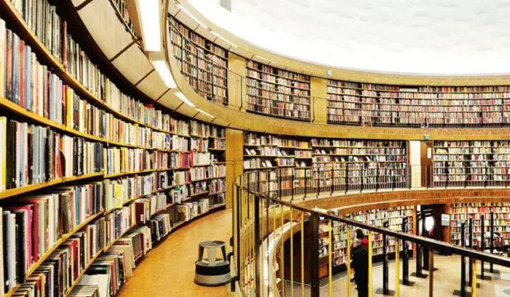
Source:
- MoU inked with the Dutch on Cosmos Malabaricus
- Cosmos Malabaricus highlighting Kerala's history based on 17th century Dutch records to be launched
Image source:
Invasive species: Senna spectabilis
- Context: A recent study, organised by a nature conservation society- Ferns, in association with the Kerala Forest Department, has revealed the spread of invasive species- Senna spectabilis through Western Ghats.
- An invasive species is an organism that causes ecological or economic harmin a new environment where it is not native.
- Senna spectabilis is found to have spread through the most iconic wildlife habitats destroying habitats of elephants, deer, gaur and tigers by pushing out native flora.
- Their rampant growth in the forest areas of the Nilgiri Biosphere Reserve (NBR), including the Wayanad Wildlife Sanctuary, is a matter of serious concern to the conservation of wildlife habitats of the Western Ghats.
- This is because, their allelopathic traits prevent other plants from growing under it. It is a form of chemical warfare where the shed leaves decompose and change the chemical composition of the soil, rendering it unsuitable for the growth of other plant species.
- Allelopathy refers to a phenomenon whereby plants produce natural products that suppress the growth of their neighbors. This drastically affects primary productivity at the ground level.
- The invasive species is also found to have spread throughout Bandipur and Nagarhole Tiger Reserves of Karnataka and the Mudumalai and Sathyamangalam Tiger Reserves in Tamil Nadu.
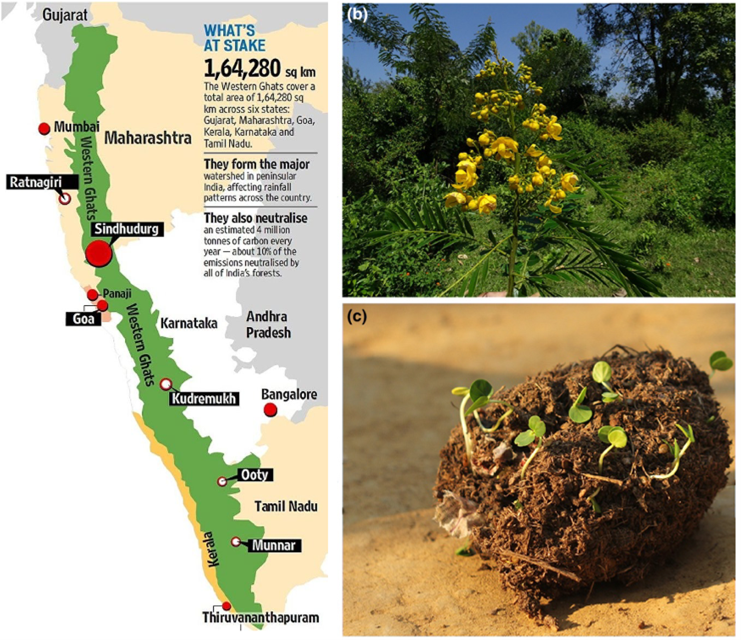
Source:
- Invasive species threatens wildlife habitats of Western Ghats
- Invasive species threatens wildlife habitats of Western Ghats
Image source:
Blue stragglers
- Context: Scientists have been trying to understand the eccentricity and the aberrant behaviour of blue stragglers with the help of the observations by the UVIT instrument.
- UVIT is the Ultraviolet Imaging Telescope of ASTROSAT, India’s first science observatory in space.
- Blue stragglers are a class of stars on open or globular clusters that stand out as they are bigger and bluer than the rest of the stars.
- These areunusually hot and bright stars found in the cores of ancient star clusters known as
- They are only found in dense stellar systems, where distances between stars are extremely small (a fraction of a light year).
- Allan Sandage was the astronomer whodiscovered blue stragglers in the globular cluster M3 in 1952-53.
- Most of these stars are located at least several thousand light-years away from the sun, and most are around 12 billion years old or more.
- TheMilky Way's largest and brightest globular is Omega Centauri.
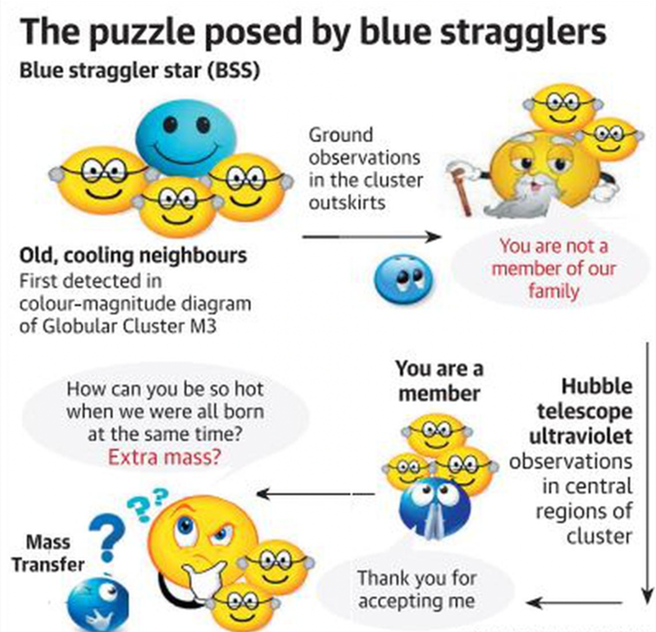
Source:
- What makes blue straggler stars tick
- Blue straggler - bigger and bluer star formed when one star eats up another
Image source:
The world is too dependent on supplies of wheat to feed itself: Livemint
Essence: As per the author, countries should think of shifting and diversifying their food supply as Ukraine war disrupted 30% of the world’s wheat supply. In short term, farmers in US, India, Canada, etc. will have to plant more wheat and people will have to replace wheat with rice and other available grains. However, in the long term, world must reduce dependency on wheat and other big staple crops.
The challenge lies in agricultural subsidies provided to produce big staple crops. These subsidies discourage diversification thus there are risks of dependency on few crops, threat of productivity drop due to extreme events caused by climate change, neglect of healthier diets such as sorghum, millet, rye, cassavas, etc.
As per the author, there is a need to diverse food supply by reorienting agriculture subsidies toward nutritious foods such as fruits, vegetables, nuts, legumes, etc. There would be opposition from farmers, however, this diversification is much needed due to increasing climate change, unstable geopolitics and to avoid chronic health problems such as diabetes and heart disease.
Why should you read this article?
- To know about the status of food prices and the remedies in the short and long term.
- To know about the flaws of the agricultural subsidies.
- To know about the authors recommendation to diversify food supply and make it more resilient.
Source:
Changing the skill development model: Indian Express
Essence: The editorial talks about the plan and need for skilling India. India wasn’t seen as the office of the world in 1947 but it now provides 5 million people in IT industry providing service for the whole world. Inability to predict future shouldn’t constrain the ability to plan and prepare. Degree apprenticeship- a tripartite contract between an employer, university, and the youth will be immensely beneficial.
The editorial talks about 5 pillars of degree apprentices- learning while earning since both employer and employee can’t afford to pay for training alone. Learning by doing- many skills like engineering, sales, customer service, logistics are moving towards skills of quality that aren’t taught but caught. Learning with flexible degree- on the job/online/on-campus/onsite, etc. Learning with qualification modularity- providing academic credits for modules learnt and removing partition between various learning institutions. Learning with signaling value- providing jobs with lesser barriers at entry and exit gates.
Why should you read this article?
- To understand the value of degree apprentice.
- To know ways in which the program could be executed.
Source:
Why reforming the system of free food is necessary: Indian Express
Essence: The editorial talks about the renewed debate on extreme poverty levels in India after WB, IMF and NITI aayog report. Both papers claim that extreme poverty in the country, based on the international definition of $1.90 per capita per day (in purchasing power parity (PPP), has declined substantially. Irrespective of whether extreme poverty is below 1 per cent, or 10 per cent or 25 per cent, and whether food transfers played a positive role in reducing poverty, a critical question remains: Why is there still a need to distribute nearly free food to 800 million people in the name of food security? Does the politics of freebies for votes make for prudent policy?
The national food security plan and PM Garib Kalyan Ann Yojana have consumed 80+ mT of food grains in FY 21. This causes deficit for the govt and creeps in systemic inefficiencies in the project. The food stock levels, FCI procurement of huge proportion of grains makes the process unsustainable. The idea for future must be tweaked to identify the Antyodaya (poorest of the poor) rather than serving 80Cr population.
There could be some problems in identifying the poor. However, technology can help overcome this difficulty. This will make PDS more targeted and lead to cost savings. This measure should be combined with giving people the option of receiving cash instead of providing grains to targeted beneficiaries.
Why should you read this article?
- To understand the unsustainable model of food procurement and distribution in India.
Source:
Free Education under the Bridge
Background
- Access to free education is still a dream for the poor, especially the children of illiterate parents, who are unaware of government policies and programmes for education.
- An initiative, Under Bridge School, is showing the way to such students.

About the Under Bridge School
- Every day, roughly 150 students from the Yamuna Khadar region of Delhi attend a makeshift school. This school provides free education, and students no longer have to worry about being unable to enrol in online programmes.
- The school is operated by Naresh Pal, a UPSC aspirant from Uttar Pradesh, who aims to provide free education to impoverished students in the neighbourhood.
- As a child, he saw how his parents, both farmers, were unable to provide him with a proper education due to their limited financial resources. Even when he was in college, he had to take up private tuitions to pay for his education.
- While Naresh has been teaching students on the banks of the Yamuna River for the past ten years, the 'Free School Under The Bridge' was born as a result of the educational burden imposed by COVID-19 lockdowns.
- There is no roof, no walls, and no tables and chairs in the school. It does, however, have stationery and bathrooms owing to gifts from generous strangers and well-wishers.
Quote: Change is the end result of all true learning. – Leo Buscaglia
Source:
Share the article
Get Latest Updates on Offers, Event dates, and free Mentorship sessions.

Get in touch with our Expert Academic Counsellors 👋
FAQs
UPSC Daily Current Affairs focuses on learning current events on a daily basis. An aspirant needs to study regular and updated information about current events, news, and relevant topics that are important for UPSC aspirants. It covers national and international affairs, government policies, socio-economic issues, science and technology advancements, and more.
UPSC Daily Current Affairs provides aspirants with a concise and comprehensive overview of the latest happenings and developments across various fields. It helps aspirants stay updated with current affairs and provides them with valuable insights and analysis, which are essential for answering questions in the UPSC examinations. It enhances their knowledge, analytical skills, and ability to connect current affairs with the UPSC syllabus.
UPSC Daily Current Affairs covers a wide range of topics, including politics, economics, science and technology, environment, social issues, governance, international relations, and more. It offers news summaries, in-depth analyses, editorials, opinion pieces, and relevant study materials. It also provides practice questions and quizzes to help aspirants test their understanding of current affairs.
Edukemy's UPSC Daily Current Affairs can be accessed through:
- UPSC Daily Current Affairs can be accessed through Current Affairs tab at the top of the Main Page of Edukemy.
- Edukemy Mobile app: The Daily Current Affairs can also be access through Edukemy Mobile App.
- Social media: Follow Edukemy’s official social media accounts or pages that provide UPSC Daily Current Affairs updates, including Facebook, Twitter, or Telegram channels.

